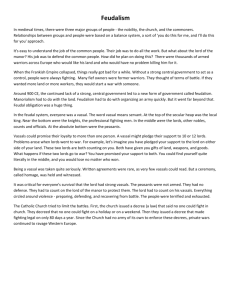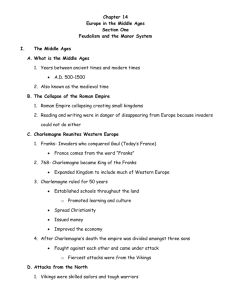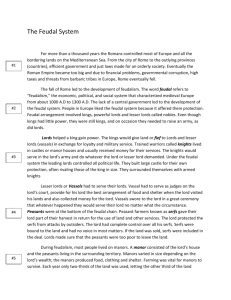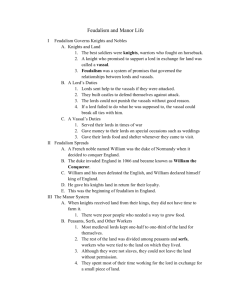Name - Arapahoe High School
advertisement
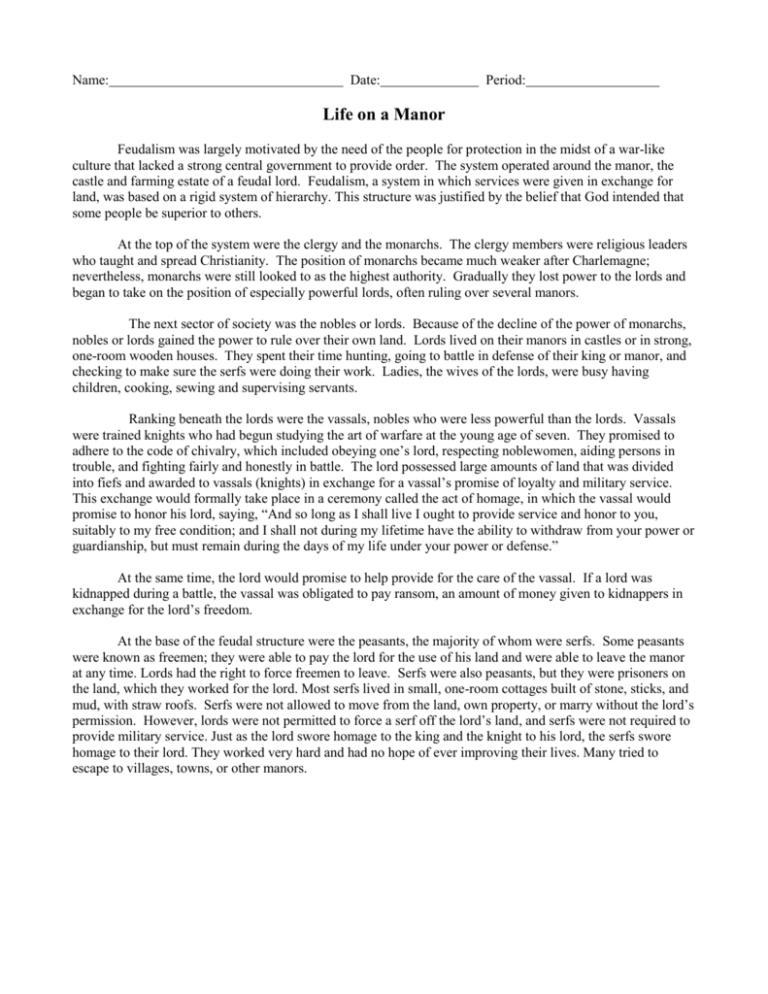
Name: Date: Period: Life on a Manor Feudalism was largely motivated by the need of the people for protection in the midst of a war-like culture that lacked a strong central government to provide order. The system operated around the manor, the castle and farming estate of a feudal lord. Feudalism, a system in which services were given in exchange for land, was based on a rigid system of hierarchy. This structure was justified by the belief that God intended that some people be superior to others. At the top of the system were the clergy and the monarchs. The clergy members were religious leaders who taught and spread Christianity. The position of monarchs became much weaker after Charlemagne; nevertheless, monarchs were still looked to as the highest authority. Gradually they lost power to the lords and began to take on the position of especially powerful lords, often ruling over several manors. The next sector of society was the nobles or lords. Because of the decline of the power of monarchs, nobles or lords gained the power to rule over their own land. Lords lived on their manors in castles or in strong, one-room wooden houses. They spent their time hunting, going to battle in defense of their king or manor, and checking to make sure the serfs were doing their work. Ladies, the wives of the lords, were busy having children, cooking, sewing and supervising servants. Ranking beneath the lords were the vassals, nobles who were less powerful than the lords. Vassals were trained knights who had begun studying the art of warfare at the young age of seven. They promised to adhere to the code of chivalry, which included obeying one’s lord, respecting noblewomen, aiding persons in trouble, and fighting fairly and honestly in battle. The lord possessed large amounts of land that was divided into fiefs and awarded to vassals (knights) in exchange for a vassal’s promise of loyalty and military service. This exchange would formally take place in a ceremony called the act of homage, in which the vassal would promise to honor his lord, saying, “And so long as I shall live I ought to provide service and honor to you, suitably to my free condition; and I shall not during my lifetime have the ability to withdraw from your power or guardianship, but must remain during the days of my life under your power or defense.” At the same time, the lord would promise to help provide for the care of the vassal. If a lord was kidnapped during a battle, the vassal was obligated to pay ransom, an amount of money given to kidnappers in exchange for the lord’s freedom. At the base of the feudal structure were the peasants, the majority of whom were serfs. Some peasants were known as freemen; they were able to pay the lord for the use of his land and were able to leave the manor at any time. Lords had the right to force freemen to leave. Serfs were also peasants, but they were prisoners on the land, which they worked for the lord. Most serfs lived in small, one-room cottages built of stone, sticks, and mud, with straw roofs. Serfs were not allowed to move from the land, own property, or marry without the lord’s permission. However, lords were not permitted to force a serf off the lord’s land, and serfs were not required to provide military service. Just as the lord swore homage to the king and the knight to his lord, the serfs swore homage to their lord. They worked very hard and had no hope of ever improving their lives. Many tried to escape to villages, towns, or other manors.
